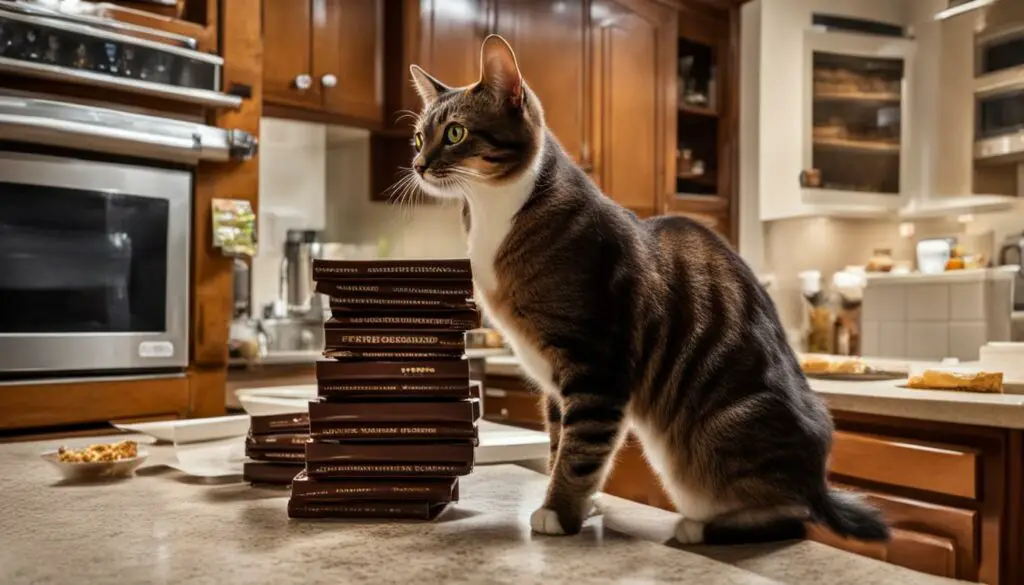Welcome to our article on chocolate toxicity in cats! As a cat owner, you may wonder if a tiny bit of chocolate can harm your feline friend. The answer is yes – even a small amount of chocolate can be dangerous for cats. In this article, we will explore the dangers of chocolate for cats, the symptoms of chocolate poisoning, the treatment options available, and how to prevent chocolate poisoning in cats.
Key Takeaways:
- Chocolate is toxic to cats due to the presence of caffeine and theobromine.
- Even a tiny bit of chocolate can cause symptoms such as vomiting, diarrhea, increased heart rate, and even seizures in cats.
- Dark chocolate and baking chocolate are especially dangerous for cats.
- If you suspect your cat has ingested chocolate, seek immediate veterinary care.
- Prevention is key – keep chocolate out of your cat’s reach and opt for safe cat treats instead.
Is Chocolate Bad for Cats?
Yes, chocolate is bad and toxic to cats. It contains caffeine and theobromine, which can cause severe toxicity in cats. Dark chocolate and baking chocolate are especially dangerous due to their high concentrations of these compounds. Even small amounts of chocolate, including white chocolate, can potentially cause issues in cats. The sugar and fat found in chocolate are not toxic but can still be harmful to cats.
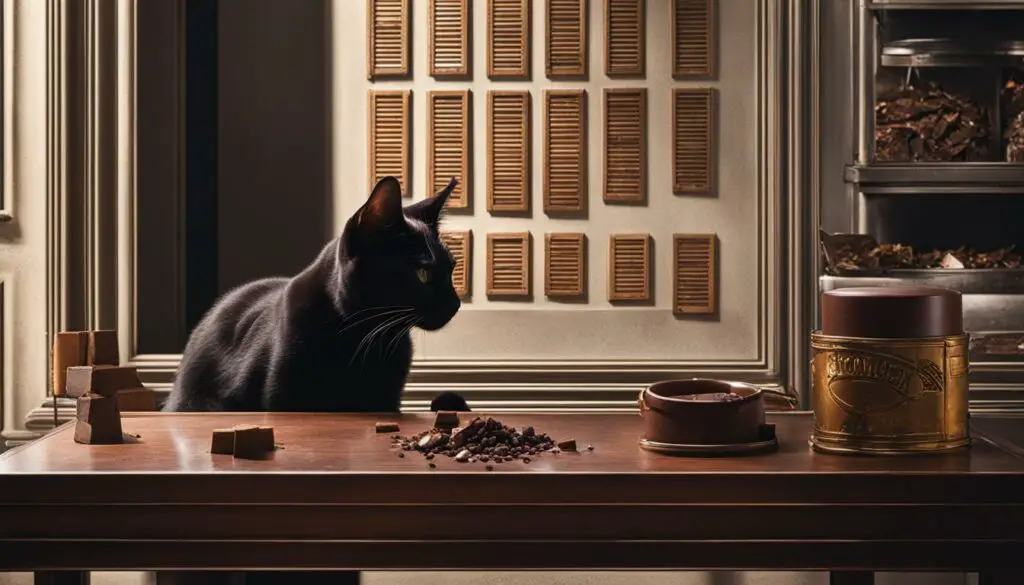
It’s important to keep chocolate out of your cat’s reach and securely stored in a tightly sealed container. Foods that contain chocolate, such as ice cream, milk, and pudding, are likely to be less toxic to cats than pure chocolate, but they can still be harmful. Cats may not tolerate the lactose in milk products well, leading to vomiting and diarrhea. Additionally, the fat and sugar in these foods can be detrimental to a cat’s health. It’s best to avoid giving cats any form of chocolate or chocolate-containing foods.
Remember, even licking a small amount of chocolate, especially milk chocolate, is unlikely to cause harm to cats. However, it’s always safer to contact poison control or your veterinarian if you suspect that your cat has ingested any chocolate at all. It’s better to be cautious and seek professional advice rather than risking potential harm to your feline friend.
| Type of Chocolate | Danger Level |
|---|---|
| Dark Chocolate | High |
| Baking Chocolate | High |
| White Chocolate | Low |
Can Cats Eat Chocolate Ice Cream, Milk, or Pudding?
While chocolate is toxic to cats, some cat owners may wonder if their feline friends can safely consume chocolate-flavored treats like ice cream, milk, or pudding. Unfortunately, these foods can still be harmful to cats, albeit to a lesser extent than pure chocolate.
One important consideration is that cats are lactose intolerant. Consuming milk products can lead to digestive upset, including vomiting and diarrhea. So, even if a chocolate ice cream or chocolate milk doesn’t contain a toxic amount of theobromine, the lactose in these products can still cause discomfort for cats.
In addition to the potential lactose intolerance issues, chocolate-flavored treats often contain high levels of fat and sugar. These ingredients can be detrimental to a cat’s health, causing weight gain, dental problems, and even diabetes. It’s best to avoid giving cats any form of chocolate or chocolate-containing foods.
Remember, cats are obligate carnivores, meaning their bodies are designed to thrive on a diet of meat. To ensure your cat’s optimal health, stick to cat-specific treats and avoid sharing any human foods, especially those that contain chocolate. Your veterinarian can provide guidance on suitable treats and a balanced diet for your feline companion.
| Food Item | Potential Risks for Cats |
|---|---|
| Chocolate Ice Cream | – Contains theobromine, which is toxic to cats – Can cause lactose intolerance-related digestive issues – High levels of fat and sugar can be detrimental to a cat’s health |
| Chocolate Milk | – Contains theobromine, which is toxic to cats – Can cause lactose intolerance-related digestive issues – High levels of fat and sugar can be detrimental to a cat’s health |
| Chocolate Pudding | – Contains theobromine, which is toxic to cats – Can cause lactose intolerance-related digestive issues – High levels of fat and sugar can be detrimental to a cat’s health |
Remember: Always prioritize your cat’s well-being and consult with your veterinarian regarding the appropriate foods and treats for your furry friend.
Signs of Chocolate Poisoning in Cats
Chocolate poisoning in cats can have serious consequences and it’s important to be aware of the signs and symptoms. If your cat has ingested chocolate, watch out for the following indicators of chocolate poisoning:
- Vomiting
- Diarrhea
- Decreased appetite
- Increased thirst
- Increased urination
- Increased heart rate
- Restlessness
- Panting or rapid breathing
- Muscle tremors
- Seizures
- Coma
If you notice any of these signs in your cat, it’s crucial to seek immediate veterinary care. The severity of the symptoms can vary depending on the amount and type of chocolate ingested, as well as the individual cat’s sensitivity. Timely intervention and treatment can significantly improve the chances of a positive outcome.
Remember, even a small amount of chocolate can be harmful to cats, so it’s essential to keep all chocolate products out of their reach. Prevention is key in avoiding chocolate poisoning in cats and ensuring their well-being. If you suspect that your cat has ingested chocolate or any chocolate-containing foods, it’s always better to seek professional advice.
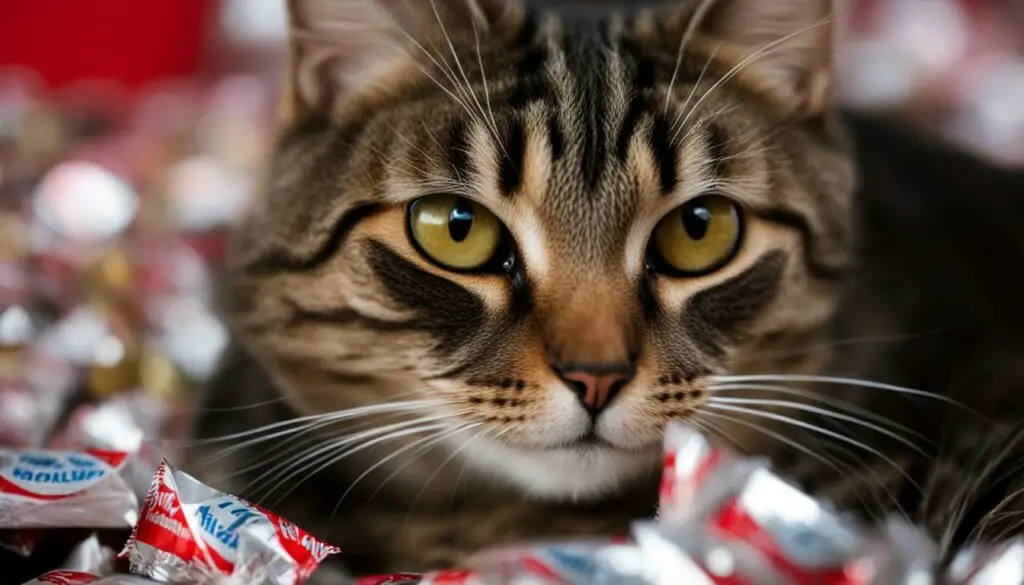
| Type of Symptom | Description |
|---|---|
| Vomiting and Diarrhea | Chocolate can irritate the digestive system, leading to vomiting and diarrhea. These symptoms are usually among the first signs of chocolate poisoning in cats. |
| Increased Thirst and Urination | The compounds in chocolate can affect a cat’s metabolism and lead to increased thirst and urination. This is the body’s way of trying to eliminate the toxins. |
| Increased Heart Rate and Restlessness | Caffeine and theobromine in chocolate can stimulate the nervous system, causing an elevated heart rate and restlessness in cats. |
| Muscle Tremors and Seizures | In more severe cases of chocolate poisoning, cats may experience muscle tremors and seizures. These symptoms indicate a significant level of toxicity and require immediate veterinary attention. |
| Coma | In extreme cases, chocolate poisoning can lead to a coma. This is a critical condition that can be life-threatening for cats. |
It’s important to remember that cats should never be given chocolate as a treat, no matter how small the amount may be. Always prioritize your cat’s health and well-being by keeping chocolate products securely stored and out of their reach.
Can Cats Die From Chocolate?
When it comes to cats and chocolate, the risks are real. While cats may be curious creatures, their bodies are not equipped to handle the toxic compounds found in chocolate. Theobromine and caffeine, present in varying amounts depending on the type of chocolate, can have severe consequences for our feline friends.
So, can cats die from chocolate? The answer is yes, under certain conditions. The severity of chocolate toxicity in cats depends on factors such as the size of the cat and the type of chocolate ingested. Smaller amounts of dark chocolate, baking chocolate, and cocoa beans can be potentially fatal.
Veterinary care is crucial when a cat has ingested chocolate. The changes in heart rate and body temperature caused by chocolate toxicity can be life-threatening if left untreated. Seeking immediate professional help increases the chances of survival for our furry companions.
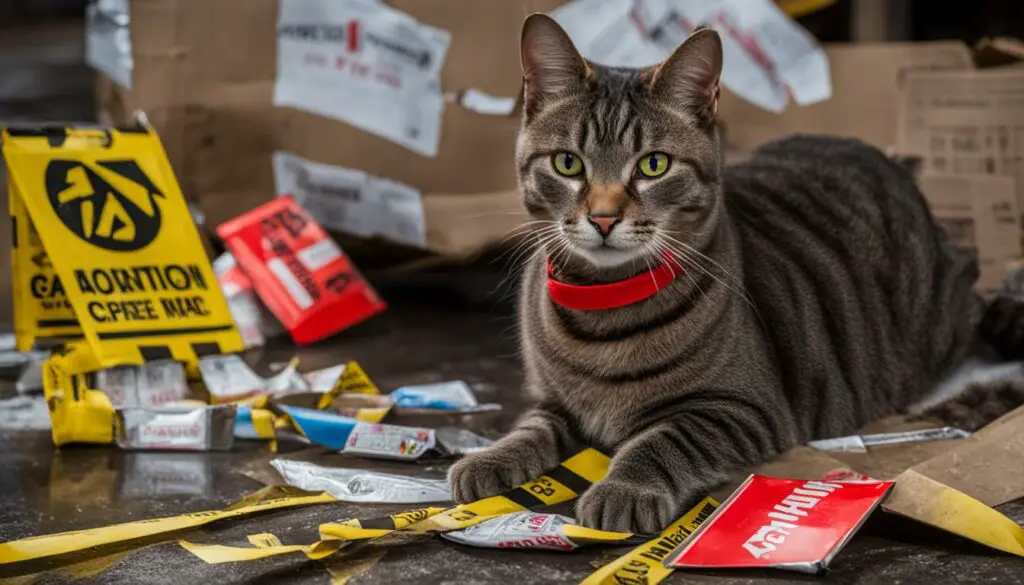
To better understand the potential dangers, let’s take a look at the table below, which outlines the toxicity levels of different types of chocolate for cats:
| Type of Chocolate | Theobromine Content | Risk Level |
|---|---|---|
| Milk Chocolate | 44-64 mg/oz | Low to Moderate |
| Semi-Sweet Chocolate | 150-260 mg/oz | Moderate to High |
| Baking Chocolate | 390-450 mg/oz | High to Extremely High |
As we can see from the table, even a small amount of baking chocolate can put our cats at a high risk of chocolate toxicity. It’s crucial to be vigilant and keep all forms of chocolate away from our feline companions, ensuring their safety and well-being.
What to Do If Your Cat Eats Chocolate
If you suspect that your cat has eaten chocolate, it’s crucial to take immediate action to ensure their well-being. Here are the steps to follow:
- Contact your veterinarian or a pet poison helpline right away. They will provide you with professional guidance on how to proceed based on your cat’s specific situation.
- Do not try to induce vomiting at home without professional advice. The type and amount of chocolate ingested, as well as your cat’s overall health, need to be considered before making any decisions. Your veterinarian will determine if inducing vomiting is necessary.
- Provide all the necessary information about the chocolate ingested, including the type (dark, milk, white), amount, and time of ingestion. This will help the veterinary team assess the potential risk and plan the most suitable treatment.
- Follow your veterinarian’s instructions carefully. They may recommend bringing your cat in for an examination or providing supportive care at home, depending on the severity of the chocolate ingestion. Treatment options may include inducing vomiting, administering activated charcoal to bind the toxins, providing fluid therapy, and using medications to manage symptoms.
Remember, it’s crucial to seek veterinary care as soon as possible if you suspect your cat has eaten chocolate. Timely intervention can significantly increase the chances of a positive outcome.
“If you suspect that your cat has eaten chocolate, it’s crucial to take immediate action to ensure their well-being.”
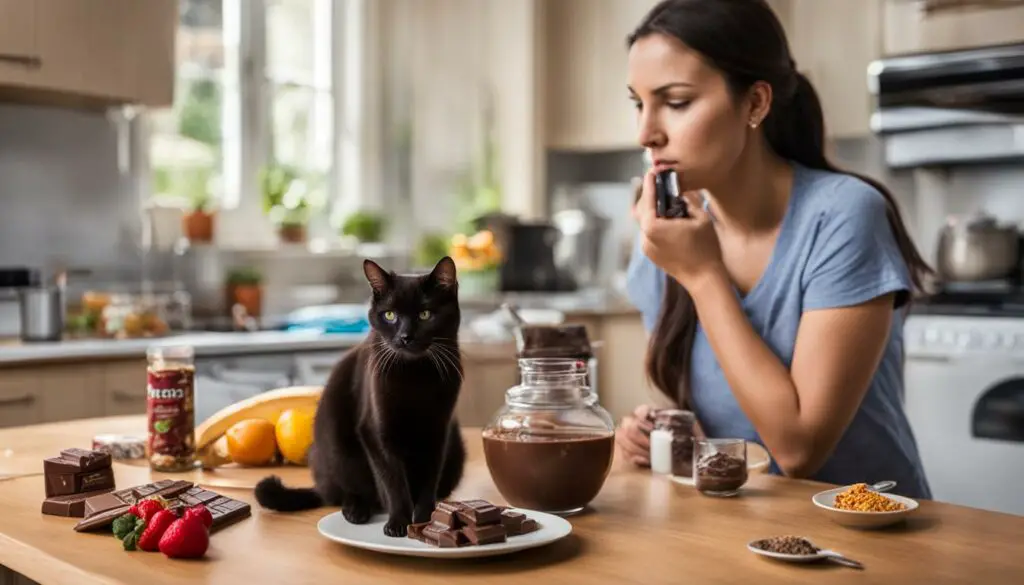
Can Cats Lick Chocolate?
While chocolate is toxic to cats and should be avoided, licking a small amount of chocolate, especially milk chocolate, is unlikely to cause immediate harm. However, even small amounts of dark unsweetened chocolate can be problematic. It’s important to remember that chocolate toxicity in cats is dose-dependent, meaning that the more chocolate a cat consumes, the greater the risk of poisoning. Therefore, it’s better to err on the side of caution and prevent cats from licking or consuming any chocolate at all.
Chocolate contains two compounds, caffeine and theobromine, that are toxic to cats. These substances can cause symptoms such as vomiting, diarrhea, increased heart rate, restlessness, muscle tremors, seizures, and even coma. The severity of the symptoms depends on factors such as the type of chocolate, the cocoa content, and the size of the cat. Therefore, it’s crucial to keep all forms of chocolate out of your cat’s reach to prevent accidental ingestion.
“Even small amounts of chocolate, including white chocolate, can potentially cause issues in cats.”
If you suspect that your cat has ingested any chocolate, it’s important to contact poison control or your veterinarian for guidance. The veterinary team can assess the situation and provide appropriate advice or treatment. It’s always better to seek professional advice rather than waiting for symptoms to appear, as immediate intervention can help prevent further absorption of toxins and improve the cat’s chances of a full recovery.
| Type of Chocolate | Risk Level for Cats |
|---|---|
| Milk Chocolate | Low to Moderate |
| Dark Chocolate | Moderate to High |
| Baking Chocolate | High to Extremely High |
Remember, prevention is key when it comes to keeping your cat safe from chocolate toxicity. Keep all chocolate products securely stored in a place your cat cannot access. Be mindful of foods and treats that may contain chocolate, and ensure they are stored safely. If you want to reward your feline friend, stick to safe cat treats specifically made for their consumption. By being vigilant and proactive, you can help protect your cat from the risks associated with chocolate ingestion.
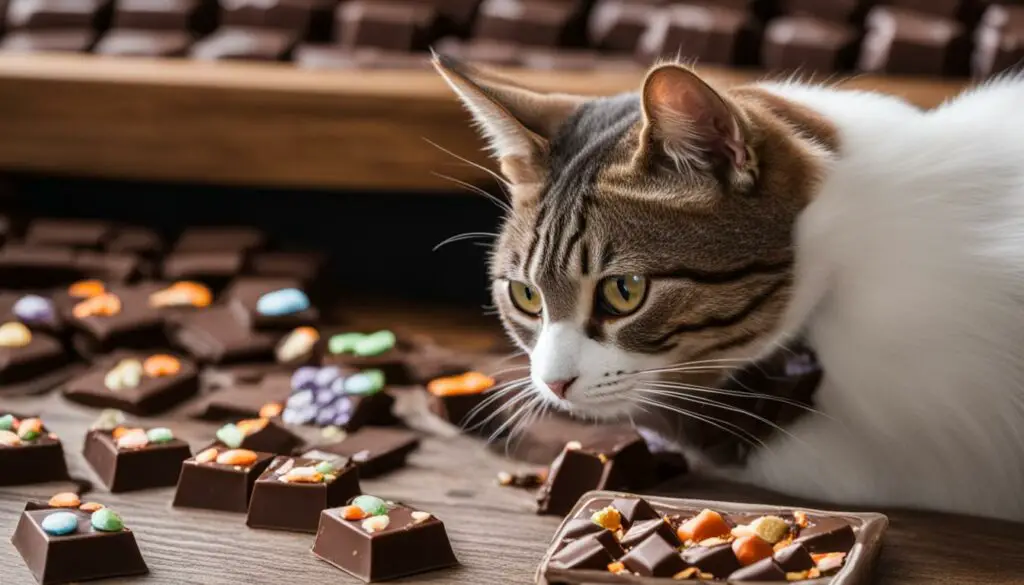
Treatment of Chocolate Toxicity in Cats
When it comes to treating chocolate toxicity in cats, prompt veterinary intervention is crucial to ensure the best possible outcome. The treatment plan for a cat that has ingested chocolate will depend on the severity of the poisoning and the individual cat’s condition.
In cases of chocolate ingestion, inducing vomiting may be recommended if the cat has recently ingested the chocolate. This helps to remove the toxins from their system. Activated charcoal may also be administered to bind the remaining toxins in the digestive tract, preventing further absorption into the bloodstream.
If the cat is exhibiting symptoms such as seizures or abnormal heart rhythms, medications may be given to manage these symptoms. Supportive care, including fluid therapy, may also be provided to help maintain hydration and support the cat’s overall well-being.
| Treatment Options for Chocolate Toxicity in Cats | Description |
|---|---|
| Inducing vomiting | Recommended if the cat has recently ingested chocolate to remove toxins from the system. |
| Activated charcoal administration | Binds remaining toxins in the digestive tract to prevent further absorption into the bloodstream. |
| Medication | May be given to manage symptoms such as seizures or abnormal heart rhythms. |
| Supportive care | Includes fluid therapy to maintain hydration and overall well-being of the cat. |
It’s important to remember that treatment should only be administered by a qualified veterinarian. Attempting to treat chocolate toxicity at home can be dangerous and potentially worsen the situation. Always seek professional advice and guidance when dealing with potential chocolate poisoning in cats.
Preventing Chocolate Poisoning in Cats
As a cat owner, it’s crucial to take proactive measures to prevent chocolate poisoning in your feline friend. Keeping cats away from chocolate is essential to ensure their health and well-being. Here are some practical tips to help you protect your cat from the dangers of chocolate:
1. Securely store chocolate:
Store all chocolate products in a tightly sealed container that your cat cannot open. This includes chocolate bars, cocoa powder, baking chocolate, and any other chocolate-containing foods. Place them in cabinets or high shelves, away from your cat’s reach.
2. Be mindful of holiday treats:
During holidays or when entertaining guests, be cautious about placing candy dishes or chocolate desserts in areas that are difficult for your cat to access. Avoid leaving chocolates unattended on countertops or coffee tables, as cats can be curious and resourceful when it comes to finding treats.
3. Educate family members and guests:
Inform your family members and guests about the dangers of chocolate for cats. Make sure everyone knows to keep their chocolate treats out of reach of your cat and not to share any chocolate with them. It’s better to be safe than sorry.
4. Provide safe alternatives:
Instead of sharing chocolate with your cat, offer them safe and appropriate treats specifically made for feline consumption. Many pet stores offer a variety of cat-friendly treats that are both tasty and safe for your furry friend.
By following these preventive measures, you can significantly reduce the risk of chocolate poisoning in your beloved cat. Remember, cats are curious creatures, and they don’t understand the potential dangers of chocolate. It’s our responsibility as cat owners to create a safe environment and ensure that our feline companions stay away from this toxic treat.

Why is Chocolate Bad for Cats?
Chocolate is bad for cats because it contains two compounds that are toxic to them: caffeine and theobromine. These compounds can have severe effects on a cat’s health and can lead to chocolate poisoning. Theobromine, in particular, is the main culprit when it comes to chocolate toxicity in cats. It affects their central nervous system, cardiovascular system, and other organs, leading to a range of symptoms.
When cats ingest chocolate, even in small amounts, it can cause vomiting, diarrhea, increased heart rate, restlessness, muscle tremors, seizures, and even coma. The severity of these symptoms depends on factors such as the size of the cat, the type of chocolate consumed, and the amount ingested. Dark chocolate and baking chocolate are especially dangerous because they contain higher concentrations of theobromine.
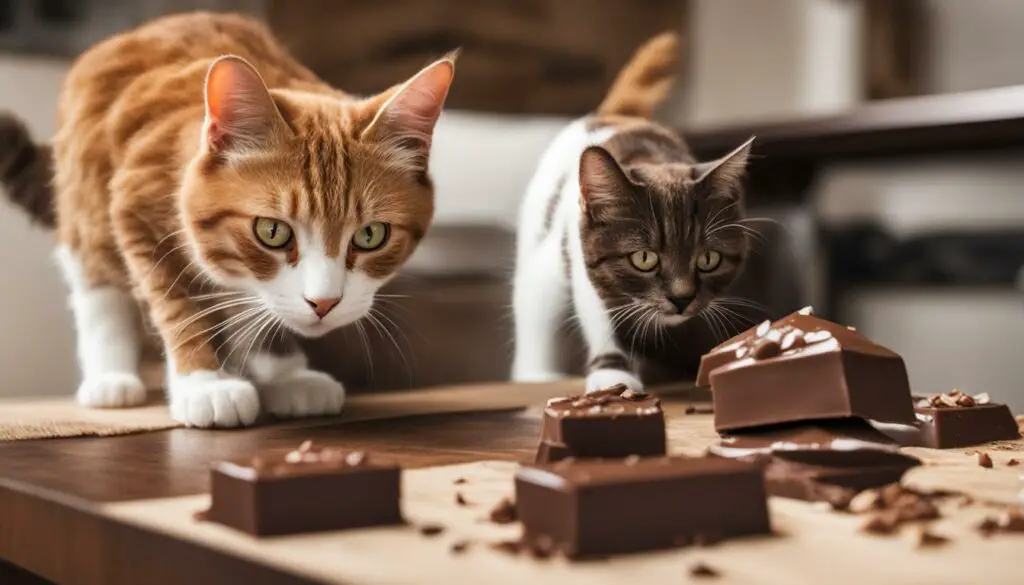
It’s important to keep chocolate away from cats to prevent them from being exposed to these harmful compounds. Even a small piece of chocolate can be dangerous for a cat, so it’s best to avoid giving them any form of chocolate or chocolate-containing foods. By being vigilant and keeping chocolate out of your cat’s reach, you can help protect them from the dangers of chocolate poisoning.
How Much Chocolate is Too Much for Cats?
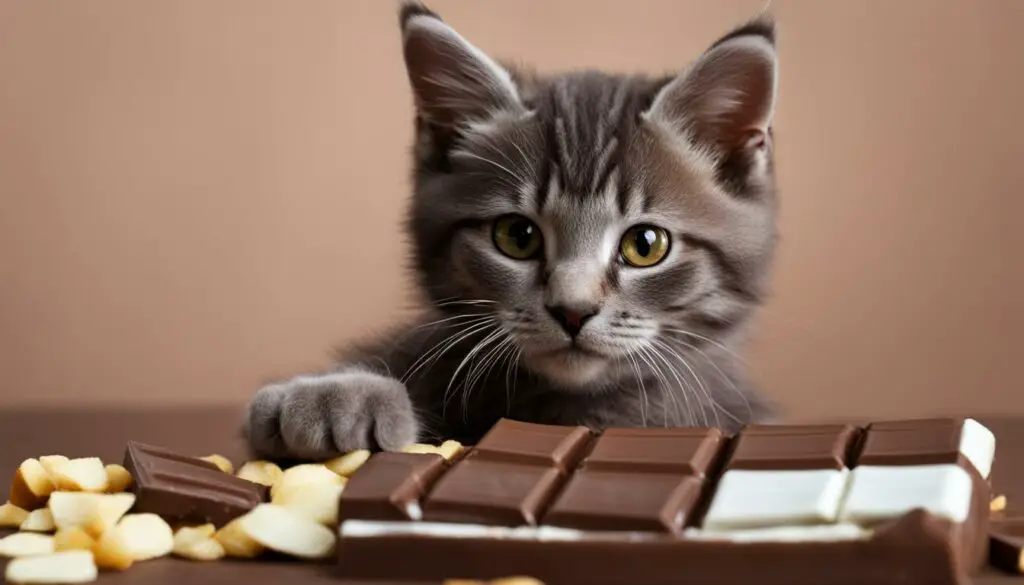
When it comes to chocolate, even a small amount can be too much for cats. The toxic dose of chocolate for cats depends on various factors, including the type of chocolate and the size of the cat. Theobromine and caffeine, the compounds found in chocolate, can have a detrimental effect on cats’ health.
Dark chocolate, baking chocolate, and cocoa powder contain higher levels of theobromine and caffeine, making them more toxic to cats. Milk chocolate and white chocolate have lower levels, but they can still be harmful if consumed in large quantities. It’s important to note that there is no safe threshold for chocolate consumption in cats.
As a responsible cat owner, it’s best to avoid letting your cat eat any chocolate. Even a tiny bit can lead to chocolate toxicity. Keep chocolate securely stored in a tightly sealed container, and be cautious about foods and treats that may contain chocolate. Stick to safe cat treats and avoid sharing any chocolate with your feline friend to prevent the risk of chocolate poisoning.
How Long After Eating Chocolate Will a Cat Get Sick?
When it comes to chocolate toxicity in cats, timing is crucial. Cats can start showing signs of chocolate poisoning within 2 hours of ingestion, but symptoms may continue to develop up to 24 hours later. It’s important not to wait for symptoms to appear if you know or suspect that your cat has eaten chocolate. Immediate veterinary care is necessary to prevent further absorption of toxins and to provide appropriate treatment for your furry friend.
The onset of symptoms can vary depending on factors such as the type and amount of chocolate consumed, as well as the individual cat’s sensitivity to the toxic compounds. It’s essential to remember that even a small amount of chocolate can be harmful to cats, so any ingestion should be taken seriously.
If you witness your cat eating chocolate or find evidence of chocolate consumption, don’t wait for symptoms to manifest. Contact your veterinarian or a pet poison helpline immediately for guidance. They can assess the situation, provide specific advice based on your cat’s condition, and recommend the appropriate course of action.
| Type of Chocolate | Onset of Symptoms |
|---|---|
| Dark Chocolate | Within 2-4 hours |
| Milk Chocolate | Within 4-6 hours |
| White Chocolate | Within 6-12 hours |
Remember, the earlier the treatment is initiated, the better the prognosis for your cat. Time is of the essence when it comes to chocolate toxicity, so don’t hesitate to seek professional help if you suspect chocolate ingestion in your feline companion.
Conclusion
In conclusion, it is crucial to understand that chocolate is extremely harmful to cats. Even a tiny bit of chocolate can lead to chocolate toxicity, which can have severe consequences for our feline friends. Symptoms such as vomiting, diarrhea, increased heart rate, and seizures can occur within hours of ingesting chocolate.
Dark chocolate and baking chocolate pose the greatest risk due to their high levels of caffeine and theobromine. However, all types of chocolate, including white chocolate, should be avoided for cats. The sugar and fat content in chocolate can also be detrimental to their health.
If you suspect that your cat has consumed chocolate, it is essential to contact your veterinarian or a pet poison helpline immediately. Prompt veterinary care is crucial for the best chances of a positive outcome. Treatment may include inducing vomiting, administering activated charcoal, and providing supportive care.
Prevention is key in avoiding chocolate poisoning in cats. Keep all chocolate products securely stored and out of your cat’s reach. Be cautious during holidays and when entertaining guests, ensuring that chocolate is not accessible to your cat. Stick to safe cat treats to reward your feline friend and never share chocolate with them.
FAQ
Will a Tiny Bit of Chocolate Hurt My Cat?
Yes, even a tiny bit of chocolate can be harmful to cats due to the presence of caffeine and theobromine, which are toxic to cats.
Is Chocolate Bad for Cats?
Yes, chocolate is bad for cats because it contains caffeine and theobromine, which can cause toxicity in cats.
Can Cats Eat Chocolate Ice Cream, Milk, or Pudding?
No, cats should not eat chocolate ice cream, milk, or pudding. These foods can still be harmful to cats due to lactose intolerance, sugar, and fat content.
What Are the Signs of Chocolate Poisoning in Cats?
Signs of chocolate poisoning in cats may include vomiting, diarrhea, increased thirst, increased heart rate, restlessness, muscle tremors, seizures, and coma.
Can Cats Die From Chocolate?
Yes, under certain conditions, cats can die from eating chocolate. The severity of the toxicity depends on factors such as the size of the cat and the type of chocolate ingested.
What Should I Do If My Cat Eats Chocolate?
If your cat eats chocolate, it’s important to contact your veterinarian or a pet poison helpline immediately for guidance. Do not induce vomiting at home without professional guidance.
Can Cats Lick Chocolate?
While licking a small amount of chocolate, especially milk chocolate, is unlikely to cause harm to cats, even small amounts of dark unsweetened chocolate can be problematic.
What Is the Treatment for Chocolate Toxicity in Cats?
Treatment for chocolate toxicity in cats may include inducing vomiting, administering activated charcoal, providing supportive care, fluid therapy, and medication to manage symptoms.
How Can I Prevent Chocolate Poisoning in Cats?
Chocolate ingestion in cats is 100% preventable. Keep chocolate out of your cat’s reach and securely stored. Be cautious of foods and treats that may contain chocolate, and avoid sharing chocolate with your cat.
Why Is Chocolate Bad for Cats?
Chocolate is bad for cats due to the presence of caffeine and theobromine, which are toxic to cats and can cause severe health complications.
How Much Chocolate is Too Much for Cats?
Any amount of chocolate can be harmful to cats. The toxicity of chocolate depends on factors such as the type of chocolate, cocoa content, and the size of the cat.
How Long After Eating Chocolate Will a Cat Get Sick?
Cats can start showing signs of chocolate toxicity within 2 hours of eating chocolate. Symptoms may continue to develop up to 24 hours later.

